- Welcome
- Use case
- Getting Started
-
Searching Records
- Performing a Basic Search
- Performing an Advanced Search
- Performing a List Search
- Performing a Keyword Search of UUMC Pathology Reports for all Patients in the Database
- Performing a Keyword Search of UUMC Pathology Reports for the Patients Associated with a Specific Set of Specimens
- Restrictions on Searches
- Reports
-
iQ Tool
- Adding Columns to a Query
- Starting the iQ Tool
- iQ Tool Window
- Current Query Data Group
- Saved Queries List
- Top Portion of the Selected
- Display or Report Columns Section
- Find/Filters Section
- Running a Preexisting Query
- Creating a Query
- Create Query Window
- Copying and Altering a Preexisting Query
- Removing Columns from a Query
- Editing Column Parameters in a Query
- Changing the Order of Columns in a Query
- Adding Filters to a Query
- Editing Filters in a Query
- Ways of Comparing Data
- Removing Filters From a Query
- Results Window
- Application Data Structure
- Application Database Fields Alphabetical List
- Application Datatree
- Field Paths List for the iQ Tool
-
Adding Specimens to the Database
- Adding a Single Specimen using the Add Specimen Wizard
- Adding a Batch of Specimens using the Add Specimen Expert Tool
- Saving a Batch of Specimens to be added as a Work in Progress
- Finishing a Work in Progress Batch
- Printing Barcodes for a Specimens in a Batch added using the Add Specimen Expert Tool
- Customizing the Add Specimen Expert Tool to Streamline Specimen Batch Entry
- Changing which Box an Add Expert Template Points for Adding Storage
- Importing FFPE Samples from UUMC
- Entering and Editing Specimen Records
- Transformations
- Specimen Disbursement and Registration
- Reports and Records
- Adding a Pathology Report to a Specimen Record
- Performing a DEXT Import of a Pathology Import
- Checking on the status of your DEXT Import Request
- Adding a Medical Record to a Specimen Record
- Editing Patient or Collection Records
- Editing Collection Records
- Editing Patient Records
- Diagnoses
- Adding a Diagnosis to a Patient Record
- Linking an Existing Diagnosis to one or more Collections
- Linking a Collection to a Diagnosis
- Recording a Consent for a Patient
- Reviewing a Patient's Consents
- Uploading a Patient's Consent Form
- Managing Patient Consents
- External (to itBioPath) Data Sources
- Managing Dictionaries
-
Storage
- Editing Aliquots
- Connecting a Barcode Label Printer to itBioPath
- Removing a Barcode Label Printer from itBioPath
- Freezer Management
- Viewing the Contents of a Box in a Freezer
- Accessing the Specimen Record for the Specimen associated with an Aliquot
- Editing Box Details
- Adding a New Box to a Freezer from the Add Aliquot Window
- Managing Protocols, Projects, and Related User Permissions
- Window, Tab, and Field Descriptions
- Miscellaneous
To record a patient consent in itBioPath:
- Select Edit-Patient Consents in the application menu. The Search Patient Consent window will appear.
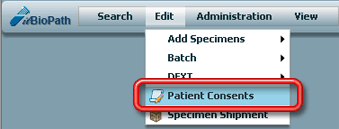
- Enter appropriate search criteria in the fields and click Search to view available consent records. (An identifying patient alias such as the patient’s MRN or HCI Person ID will find all consents for that specific patient.) The Patient Consents area of the window will be populated with consents matching the search criteria.
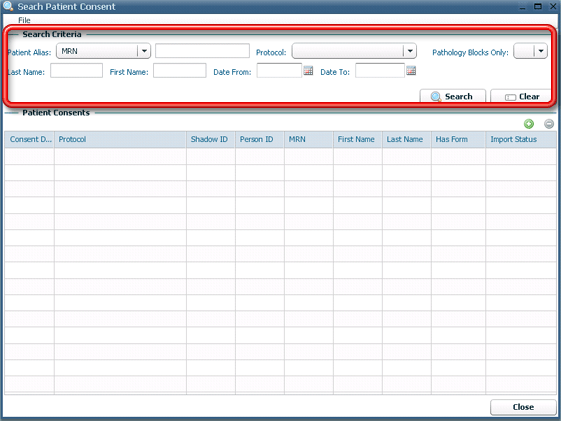
- Verify the consent has not previously been added to the database.
- Click
 above the Patient Consents list to add a new consent record. The Add Consent dialog window will open.
above the Patient Consents list to add a new consent record. The Add Consent dialog window will open.

- Enter the information about the consent on the top half of the dialog window.
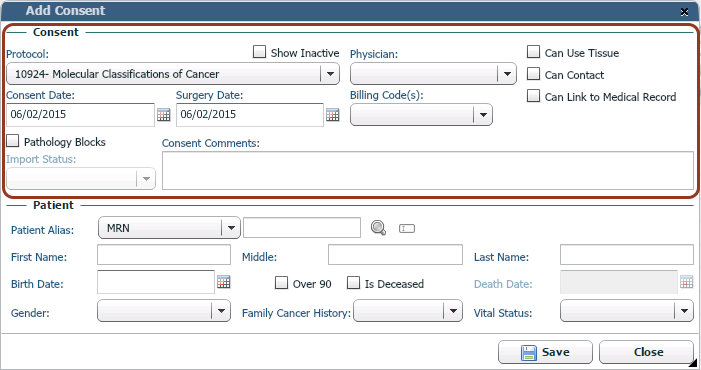
- Enter a Patient ID such as the patient's MRN or HCI Person ID and click
 to associate a patient to the consent. The fields in the Patient area will autofill if a record for the patient already exists in the database.
to associate a patient to the consent. The fields in the Patient area will autofill if a record for the patient already exists in the database.
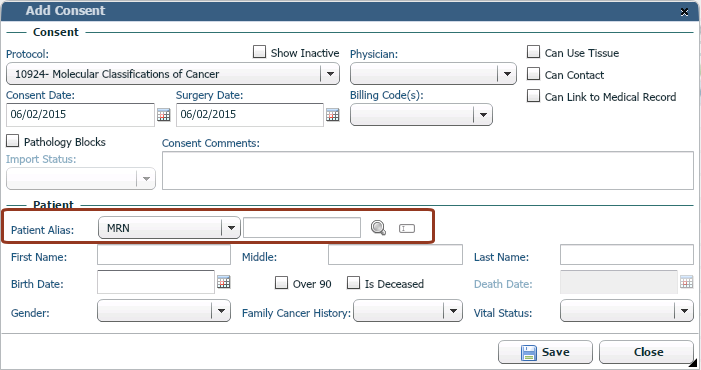
- If the patient was not found, enter the missing patient record information in the Patient area.
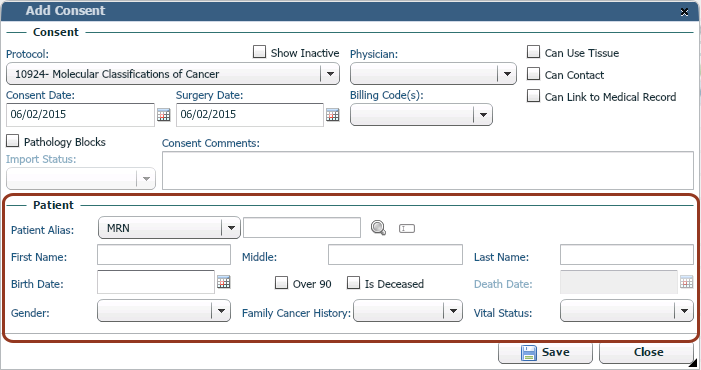
- Click
 to save the new Consent record. The Consent window will open. Add additional information about the consent and/or upload a scan of the consent form to the database.
to save the new Consent record. The Consent window will open. Add additional information about the consent and/or upload a scan of the consent form to the database.
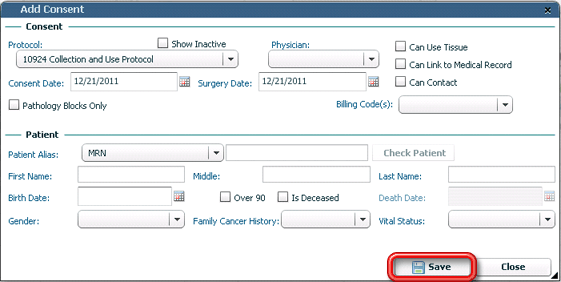
- To upload a scanned consent form, see Uploading a Consent Form for instructions on how to do so.




